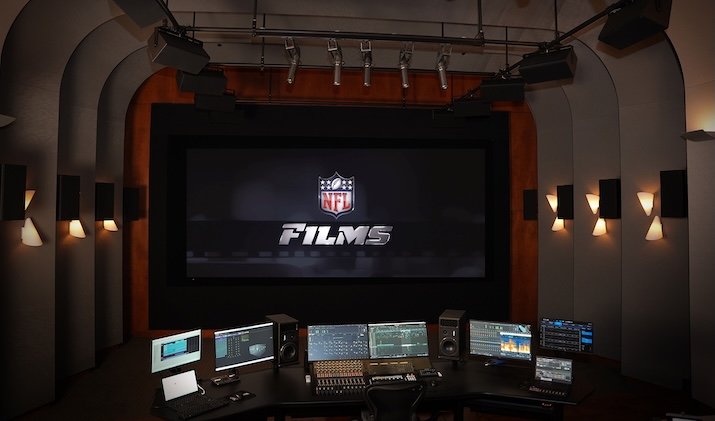Forty-three channels of audio enable the facility to migrate to immersive
NFL Films, the league’s media-production arm, has upgraded the audio of the largest production stage at its Mount Laurel, NJ, facility. A custom Dolby Atmos loudspeaker array was installed during renovation of the control room of Studio D, a 3,600-sq.-ft., 360-degree sound stage. Completed this year, the redesign was accomplished by the original acoustical designer, Dallas-based Russ Berger Design Group. The audio produced and mixed by the studio for such programs as Hard Knocks, NFL Game of the Week, and Inside the NFL will migrate to Atmos immersive sound over the course of the coming year.
NFL Films’ Vince Caputo: “Our elements are obviously crowds but also PA voices, jet flyovers, fireworks, bands. All these lend themselves to immersive-reality productions. We’re ready for all of that.”
“It seemed like the right time to go Dolby Atmos,” says NFL Films VP/supervising sound mixer Vince Caputo, who oversaw the project. “The majority of our content would be produced for streaming services and our partners at Amazon and Netflix, etc. We’re not going to put a 7.1.4 home-theater system in this room, a cinema-size room. So we went full, Dolby-certified cinema sound.”
He notes some upcoming productions that the room will mix and lay back: The Kingdom, a six-episode series on ESPN; Unreal, a 10-part series on the WWE for Netflix; and the upcoming second season of Quarterback, a seven-part series on Netflix. “These are all shows that we are producing in 5.1 or 7.1 and [for] which we want to offer a top-tier audio format. These are things that we would potentially produce in Atmos going forward.
A Major Project
“We had to substantially modify the room for immersive audio,” says designer Russ Berger, who first worked on the facility in the early 1980s and designed much of its 14-room audio wing. “A lot of the fabric treatments had to be removed and remade. We had to find places for the surrounds and overheads throughout the space, using pipes as supports. We also had to change out the entire front wall, building a new screen wall, behind which we also updated the entire L-C-R array to Alcon CRMS series with pro-ribbon transducers. We loved the clarity, the intelligibility, which you really need with immersive sound.”
The updated audio-control room retained its DaVinci Resolve software platform, which combines editing, color correction, visual effects, motion graphics, and audio postproduction on a single platform, with the integrated Fairlight software and desktop console as the main audio-processing component. The room is now fitted with an 18-ft. Stuart Vistascope screen with motorized masking, allowing it to be configured for various aspect ratios.
The new Atmos monitoring array, however, defies its usual X.4.2 speaker-configuration–metric nomenclature. Pulling out a calculator, Caputo adds up the speaker contingent: 43, including five front channels, 32 surrounds and overheads, four 18-in. cabinets making up the LFE, and a pair of 18-in. subs in the ceiling to bass-manage the surrounds and overheads.
Now That’s Entertainment
Studio D’s tech is on a par with anything in Hollywood — or wherever Hollywood is showing up these days, which could be anywhere: most U.S. states, including New Jersey, now have some sort of financial incentive for productions, as do nearly 100 countries — including Canada, UK, Ireland, Australia, even Thailand — and they’re building technical-production infrastructures to attract it.
With sports becoming more like — and competing with — entertainment, Caputo says, NFL Films aims to keep its edge sharp, not only to produce its own content with the same technical quality as other commercial productions but also to attract some of that increasingly peripatetic production work. He cites Skydance Sports, a joint venture of NFL Films and Skydance Media, as well as potential cinema-type projects, sports-related and otherwise, that the enhanced facility can accommodate.
“This room could play into that,” he points out, “along with the work we’re doing for the Pro Football Hall of Fame and various special projects that we do for both the league and teams.”
NFL Films is also building a 7.1.4 home-theater–type space in the facility to emulate high-end residential environments.
Launched in 1962 by filmmaker and Sports Broadcasting Hall of Famer Ed Sabol — its first commission was to document the 1962 NFL Championship Game between the New York Giants and the Green Bay Packers at Yankee Stadium, the precursor to the Super Bowl — NFL Films has a model that harks back to the era of its founding, when Hollywood studios used their own production facilities to make their motion pictures and later their television shows. However, the league’s production home base has steadily evolved over that time. Caputo, celebrating his 40th year at NFL Films this year, recounts all the technical eras the company has been through, from sprocketed-mag to multitrack tape to hard drives and cloud storage, to broadcast networks and now streaming. The newly updated Studio D is the latest iteration.
“We want to remain the premier sports-film company in the world, to offer top-tier services and production capabilities,” he says. “When one of our clients has Dolby Atmos as their top requested deliverable, we want to be able to say yes, and now we can. Our sport — football — really lends itself to immersive in all kinds of ways; our elements are obviously crowds, which are immersive in themselves, but also PA voices, jet flyovers, fireworks, bands. All these lend themselves to not only broadcast and surround but also to immersive-reality productions. We’re ready for all of that.”











